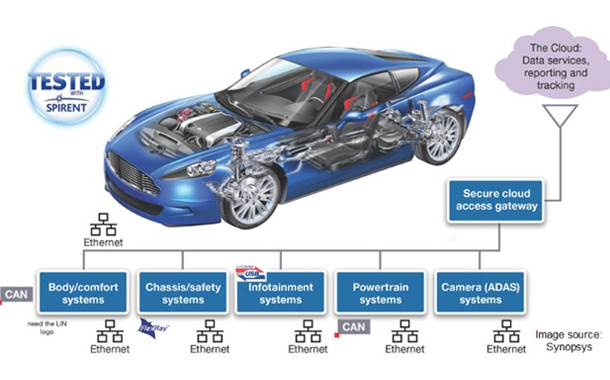New solution intros support for up to 16 individual ports for testing different kinds of physical layer
Spirent Communications announced the launch of first Automotive Ethernet Protocol Conformance & Performance Test System with the new 1000BASE-T1 physical layer standard. This solution enables automobile manufacturers and suppliers to determine if their data traffic is transmitted correctly and on-time over the market’s highest in-vehicle connectivity bandwidth.
The 1000BASE-T1 standard allows high speed and simultaneous bi-directional data traffic over lightweight, single-pair cable harnesses. This results in reduced weight and increased reliability due to the need for fewer cables and connectors in automotive applications.
Thomas Schulze, Director of Marketing and Business Development of Spirent’s Automotive business unit explains, “Available on our Automotive C1 and C50 test appliances, we are now providing a new test card with 4 Small Form-factor Plugable (SFP) ports. At the same time, we are releasing the related 1000BASE-T1 1 Gigabit Ethernet on 2-wire unshielded twisted pair cable, SFP Transceiver from Technica Engineering. Customers of our Automotive C50 test system can now use up to 16 individual ports for testing different kinds of physical layer interfaces, copper and fiber,10-1000Mbit/s.”
“As the first 1000BASE-T1 Automotive test system available, Spirent enables manufacturers to deliver competitive, innovative features while minimizing costs“, continues Schulze. “After releasing the first BroadR-Reach test system in 2014, we continue to provide state-of-the-art test solutions for the Automotive market. Strong partnerships worldwide enable Spirent to realize objectives, such as the cooperation with Technica Engineering, a leading product developer and service provider for testing on-board electronic components and networks.”
“OEMs and Tier 1s are facing huge bandwidth increases with applications like HD video cameras for autonomous driving” says Erick Parra, Business Development Manager at Technica. “These kinds of cameras are using up to 800Mbit/s for uncompressed high-definition video streaming. Therefore, most of the Automotive manufacturers are already working on a 1 Gbit/s in-vehicle network backbone for the next generation of their Advanced Driver Assistance Systems. We are proud to help pave the way into autonomous driving by combining our companies’ expertise”.
This new product release addresses the needs of companies supplying or testing Automotive Ethernet applications and networks.




